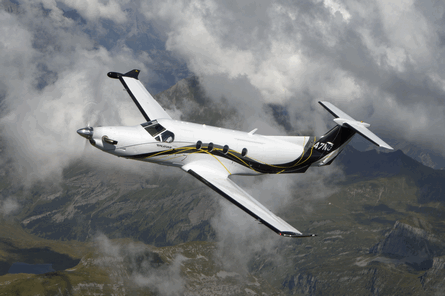The single-engined turboprop sector is riding high. Continued hikes in the price of oil worldwide, coupled with their unrivalled operational flexibility, are pushing up demand for these versatile, efficient propeller-driven aircraft.
As a leading producer of single-engined turboprops, Pilatus has delivered nearly 800 PC-12s to date and has backlogs stretching to the end of next year. "Demand is very strong," says Daniel Kunz, director of sales and marketing for the $3.8 million PC-12. "We plan to deliver 96 aircraft this year - up four on the previous year - and 105 aircraft in 2009," he says. The Stans, Switzerland-based company is poised to deliver this month the first Next Generation PC-12, having delivered the last of the old models in March.
 |
|---|
© Pilatus |
The upgraded aircraft features a Honeywell Primus Apex avionics system, a new cockpit designed by BMW Designworks USA, and a more powerful Pratt & Whitney Canada PT6A-67P engine. Kunz says the executive configured PC-12 makes up around 80% of its orders of which 10% are in fractional programmes, namely JetFly of Luxembourg and Plane Sense in the USA - where two thirds of PC-12 sales originate, says Kunz.
EADS Socata is also bucking the current business aviation industry trend with its North American customers accounting for three-quarters of TBM 850 orders. The French airframer is experiencing increasing sales activity within international markets including Australia, Brazil and Europe, despite a continued reluctance by European regulators to relax single-engined instrument flight rules for commercial operators, says EADS Socata senior vice-president Jacques Lourdon.
The Tarbes, south-west France-based company delivered 46 aircraft last year and is on track to hand over up to 30% more in 2008. The year began with the delivery of the first Garmin G1000-equipped aircraft to a US customer. This long-awaited upgrade to the 17-year-old aircraft, formally branded the 700, has helped to strengthen Socata's share of the market.
"Even with the conventional avionics we were producing 42 aircraft a year in 2006.We are planning to produce 60 aircraft this year and have sold out already," says Lourdon
Cessna's decision to install Garmin G1000 flightdecks in its Caravan utility turboprop family - the 208, the Grand Caravan (208B) and the Super Cargomaster - last year prompted a record 272 orders and a subsequent production increase at the airframer's Independence, Kansas plant.
The first upgraded aircraft is earmarked for delivery in the coming weeks. Cessna is also expanding its TKS ice-protection offering to non-cargo pod-equipped Caravans from next year. Meanwhile, Cessna is believed to be focusing on a new single, high-performance turboprop to fill the gap between its Citation Mustang very light jet and its top-end piston singles. "There is no logical progression [from the bottom of the product range] to the Mustang and we continue to look closely at this market," says Cessna senior vice-president sales and marketing Roger Whyte.
Since it began installing the Avidyne FlightMax Entegra glass cockpit as standard, Piper Aircraft has boosted Meridian fleet numbers, with 53 aircraft delivered last year. Other immediate enhancements to the $2 million aircraft are unlikely for the time being as Piper is now concentrating on bringing its PiperJet to market and the Meridian is ideally placed in Piper's line-up to transition to its new single-engined offering.
Quest Aircraft began deliveries in February of its 10-seat Kodiak six months after the seven-seat aircraft received certification. The Sandpoint, Idaho-based airframer says it has a three-year backlog of orders for the all-metal 750shp (560kW) Pratt & Whitney Canada PT6A-34-powered aircraft, which is largely funded by missionary aviation groups in exchange for receiving aircraft at cost.
Market buoyancy has also prompted kitplane manufacturer Comp Air to enter the market with its Honeywell TPE331-14GR-powered Comp Air 12, pitched against the similarly named PC-12. The eight-seat aircraft, which made its first flight earlier this year, is scheduled for certification in 2010.
Source: Flight International
















